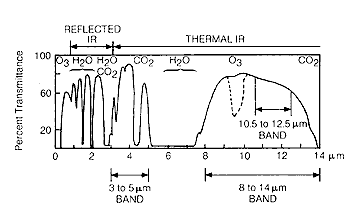
We have already had several previews of imagery that depict the thermal state of the Earth's surface. The Landsat TM Band 6 responds to varying temperatures on the ground, producing images that show the relative differences in emitted thermal energy that correlate in part with the effects of solar heating on surfaces of varying nature and orientation. This was evidenced by the obviously warmer slopes in the Morro Bay scene and the surprisingly cool surfaces of a bright, white sandstone at the Waterpocket Fold and, in seeming contradiction, the warmer surfaces associated with dark shales. As we shall see, these thermal effects also differ, sometimes drastically, in images taken during the hotter days and cooler nights. There is usually a considerable wealth of knowledge in thermal imagery - especially that obtained multispectrally - that both supplements images obtained from reflected radiation and stands alone as an information source. In this section review, we will delve rather extensively into the theory and practice of thermal remote sensing and will examine some striking examples obtained from land and water targets. However, we will avoid discussion of the use of thermal sensors to obtain temperature profiles or fix other thermal properties in the atmosphere, deferring mention of that until the later consideration of meteorological satellites.
Remote sensing of direct temperature effects is performed by sensing radiation emitted from solids, liquids, and gases in the thermal infrared region of the spectrum.Thermal sensing of solids and liquids takes place in two "windows" of the atmosphere where absorption is at a minimum, as shown in this spectral plot taken from Sabins (Remote Sensing: Principles and Interpretation, 1987).

The windows normally used from aircraft platforms are in the 3 - 5 µm and 8 - 14 µm wavelength regions; windows between 3 and 4 mm and between 10.5-12.5 µm are commonly used on spaceborne sensors. None of the windows is perfect because weak absorption by water vapor and carbon dioxide occurs and absorption by ozone affects the 10.5-12.5 µm interval. In addition, the 3 - 4 µm window is contaminated during daylight hours by some degree of solar reflectance and is used for Earth studies only when measurements are made at night.
Planck Blackbody Law
Thermal radiation is emitted in amounts determined primarily by
two properties of materials: internal temperature and emissivity.
The rate at which radiation is emitted is given by the Planck
Blackbody Law, as stated below:

A perfect blackbody is simply any (ideal) material that completely absorbs all incident radiation (converting it to internal energy) and therefore does not permit any transmittance or reflectance but emits the resultant radiant energy given off from the material at the maximum possible rate.
Code 935, Goddard Space Flight Center, NASA
Written by: Nicholas M. Short, Sr. email: nmshort@epix.net
and
Jon Robinson email: Jon.W.Robinson.1@gsfc.nasa.gov
Webmaster: Bill Dickinson Jr. email: rstwebmaster@gsti.com
Web Production: Christiane Robinson, Terri Ho and Nannette Fekete
Updated: 1999.03.15.